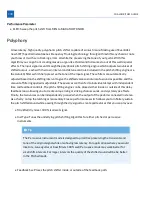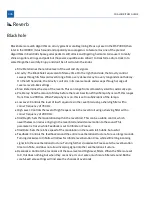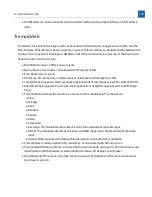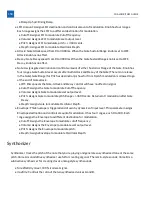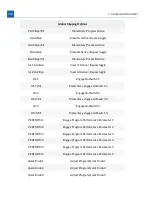
Diffusion: This alters the character of your space – from the sharp re
fl
ections of
fl
at, hard surfaces
(low) to the diffused re
fl
ections from rough, irregular ones (high). The Diffusion control doesn’t
change the decay time, but it does have an effect on the evident nature of the decay by thickening
or thinning its density. Note that this can often be a subtle difference and may be dif
fi
cult to hear
with some types of program material and/or with long decay times. The effects of the control will
be most apparent with short decays and program material with percussive attacks.
Pre Delay: Introduces a delay before the reverb effect. SP2016 Reverb is capable of long pre-
delays, up to 999 milliseconds, and these can be used to create echo effects as well.
Note
The equalization section provides controls for high and low shelving
fi
lters. These controls affect
parameters deep within the feedback structure of the reverberator and the effect may be subtle or
dramatic depending on the program material and other reverb settings such as Decay, Position, or
Diffusion. In general, the controls will have more pronounced effects at longer decay times and
more distant position settings. Additionally, it’s usually easier to hear the effect of changes to the
high frequency controls than it is to hear changes to the low frequency controls.
Low Freq: Sets the corner frequency for the low shelving
fi
lter; the range is from 50 to 500 Hz in
increments of 50 Hz.
Low Gain: Adjustable gain for the low shelving
fi
lter, from -8 to +4 dB.
High Freq: Sets the corner frequency for the high shelf
fi
lter; the range is from 1000 to 8000 Hz in
increments of 500 Hz.
High Gain: Adjustable gain for the high shelf
fi
lter, from -8 to 0 dB.
Spring
Spring models the sound and character of the popular arti
fi
cial reverbs found in guitar ampli
fi
ers. It also
goes a step further by allowing access to physical parameter controls not readily available in a real spring
tank. By tweaking these parameters, the Spring Algorithm can create faithful representations of real
springs or push the physical boundaries to achieve new distinctive sounds. Pay extra attention to the
Tension and Num Spring knobs to control the amount of ‘springiness’. For good measure, we’ve also
included a tube amp style tremolo.
Mix: Wet/dry between reverb and tremolo dry signal.
Decay: Decay in seconds or note-based with Tempo Sync on.
•
•
•
•
•
•
•
•
10. ALGORITHM GUIDE
153
Summary of Contents for H90 Harmonizer
Page 1: ......
Page 6: ...9 Software Updates ...
Page 18: ...This page was intentionally left 99 88 blank ...
Page 30: ...This page was intentionally left 99 88 blank ...
Page 38: ...This page was intentionally left 99 88 blank ...
Page 56: ...This page was intentionally left 99 88 blank ...
Page 61: ...Fig 7 6 Input level display Fig 7 7 Output level display Exp Ctl 7 SYSTEM MENU 61 ...
Page 70: ...This page was intentionally left 99 88 blank ...
Page 160: ...This page was intentionally left 99 88 blank ...
Page 162: ...This page was intentionally left 99 88 blank ...
Page 168: ...This page was intentionally left 99 88 blank ...
Page 170: ...This page was intentionally left 99 88 blank ...
Page 175: ...This page was intentionally left 99 88 blank ...
Page 176: ... Copyright 2022 Eventide Inc ...


